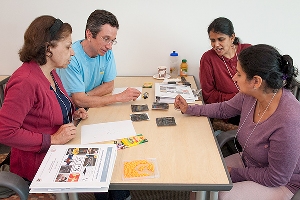Aug 1 2013
After a lecture on nanofabrication, Maria Wang, associate director at Stanford's Center for Probing the Nanoscale, handed out white paper, boxes of colored crayons, thick black crayons and pipette tips.
 Middle school teachers Maryam Raymond, left, Miguel Aznar, Sujatha Raghu and Vibha Walia discuss the results of a crayon etching activity which demonstrates the top down process used in nanofabrication.
Middle school teachers Maryam Raymond, left, Miguel Aznar, Sujatha Raghu and Vibha Walia discuss the results of a crayon etching activity which demonstrates the top down process used in nanofabrication.
It was time for a hands-on activity to illustrate the lesson for the class: science teachers from throughout the state of California who are enrolled in the center's Summer Institute for Middle School Teachers.
Following Wang's directions, the 13 teachers quickly got to work. Each filled a small square of paper with color, covered the color entirely with several layers of black crayon, then etched a design into the paper by pressing the pipette tip through the black layers to expose a colorful pattern – mimicking the plasma etching they had learned about in the lecture.
"These pipette tips are kind of high tech for this activity, but I think it's neat to find any opportunity to introduce tools that we use in the lab to you," Wang told the teachers, who were sitting at small tables in a classroom in the McCullough Building. "You can actually just use a paper clip as a low-cost solution in case you don't have access to pipette tips."
It was the second day of the weeklong institute for the teachers, who had come to Stanford to learn about the physical concepts underlying nanotechnology and nanoscience, and to develop hands-on activities to use in their classrooms. This was the eighth annual institute.
David Goldhaber-Gordon, director of the center, said most elementary school students are excited about science, but lose interest or confidence in their ability to do science during the middle school years.
"Middle school science teachers are hungry for both subject area knowledge and for reinvigorating their passion for science," said Goldhaber-Gordon, a Stanford associate professor of physics. "We select teacher participants primarily from schools with students who are traditionally underrepresented in science. In this way, we hope to impact the lives and decisions of thousands of students each year. More than ever today, as our economy is driven by scientific and technological developments, we need a scientifically literate populace. Middle school is a key time to reach students."
Real-life applications
Michael Wilson, who teaches sixth-, seventh- and eighth-grade science at Stewart Elementary School in Pinole, Calif., said crayon etching, which is taught in art classes at his school, offered the possibility of injecting a "little science" into an art lesson.
"Now we can say this is why that happens," said Wilson.
The crayon etching exercise, a demonstration of "top-down fabrication," was one of a dozen hands-on activities scheduled during the July 22-26 summer institute.
Earlier that same day, Nicholas Melosh, deputy director of the center and an associate professor of materials science and engineering at Stanford, gave a talk on the atomic structure of materials.
During the week, the teachers had the rare opportunity to interact with Stanford scientists, including faculty, staff, graduate students and postdoctoral scholars.
The teachers toured several campus labs, including the Melosh Lab and the Stanford Nanofabrication Facility, which attracts academic, industrial and government researchers from across the United States and around the world.
During the tours, the teachers saw powerful lab equipment in action, including scanning electron microscopes, which probe the surface of materials, and transmission electronic microscopes, which reveal the atomic structure of materials.
Using the scanning electronic microscope, the teachers looked at core-shell nanoparticles, which are part of an experimental study to deliver drugs to tumor cells.
Two teachers "gowned up" in clean room suits – also known as "bunny suits" – to tour the Stanford Nanofabrication Facility. The suit, which includes boots and a hood, covers the wearer to prevent skin and hair being shed into a clean room environment.
A teacher inspired
Sujatha Raghu, who teaches eighth grade at Rolling Hills Middle School in Los Gatos, Calif., said no one knows what jobs today's eighth grade students will have when they graduate from college in eight years.
"With what I'm learning here, I can introduce them to ideas related to nanotechnology," she said. "Who knows what concept might kindle their interest?"
Raghu said she especially enjoyed the lectures from "enthusiastic experts" of cutting-edge nanotechnology in the fields of physics, chemistry and medicine. She said she was impressed by the number of women at Stanford involved in nanotechnology research.
Raghu already has a plan for introducing several new hands-on activities to her students when her school resumes in mid-August.
"On the first couple of days of school, the introduction to eighth grade science is going to start with inquiry-based activities involving surface tension and probing the unknown using the sense of touch, rather than sight," she said. "I will be using activities involving the metric scale in the first month as well. All of these were made possible by this training. This was one of the best and most useful teacher training workshops that I have attended."